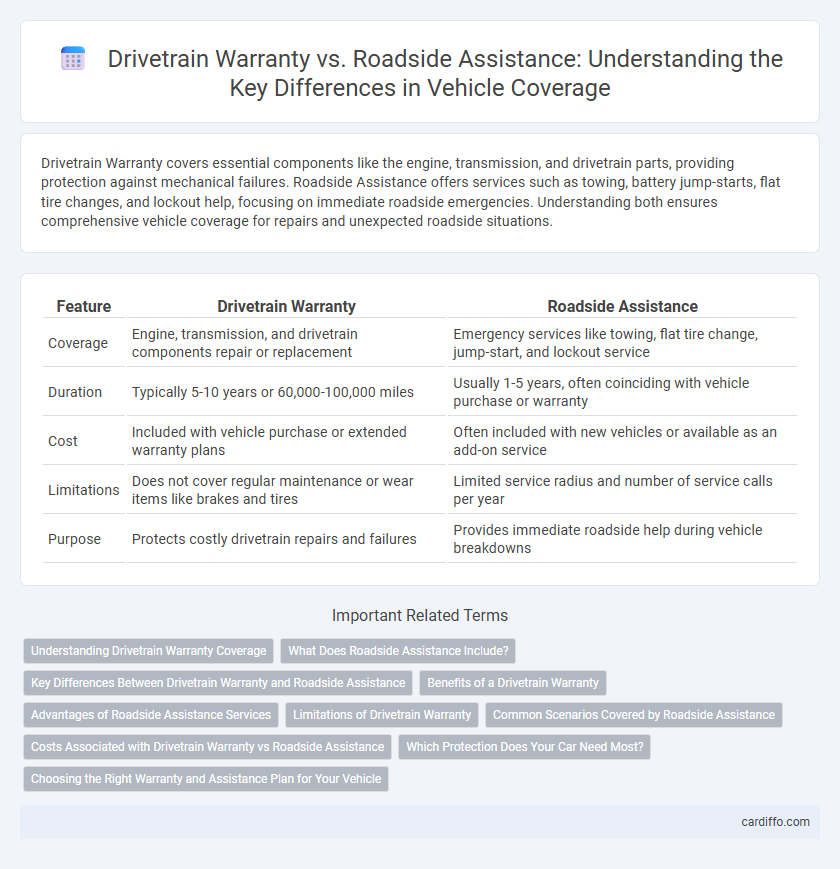Drivetrain Warranty covers essential components like the engine, transmission, and drivetrain parts, providing protection against mechanical failures. Roadside Assistance offers services such as towing, battery jump-starts, flat tire changes, and lockout help, focusing on immediate roadside emergencies. Understanding both ensures comprehensive vehicle coverage for repairs and unexpected roadside situations.
Table of Comparison
| Feature | Drivetrain Warranty | Roadside Assistance |
|---|---|---|
| Coverage | Engine, transmission, and drivetrain components repair or replacement | Emergency services like towing, flat tire change, jump-start, and lockout service |
| Duration | Typically 5-10 years or 60,000-100,000 miles | Usually 1-5 years, often coinciding with vehicle purchase or warranty |
| Cost | Included with vehicle purchase or extended warranty plans | Often included with new vehicles or available as an add-on service |
| Limitations | Does not cover regular maintenance or wear items like brakes and tires | Limited service radius and number of service calls per year |
| Purpose | Protects costly drivetrain repairs and failures | Provides immediate roadside help during vehicle breakdowns |
Understanding Drivetrain Warranty Coverage
Drivetrain warranty coverage specifically protects key vehicle components such as the transmission, drive shafts, and differential, ensuring repairs or replacements for mechanical failures. Unlike roadside assistance, which offers emergency services like towing and lockout help, drivetrain warranties focus exclusively on the functional integrity of the power delivery system. Understanding the limitations and duration of drivetrain warranties is essential for maintaining long-term vehicle reliability and managing repair costs effectively.
What Does Roadside Assistance Include?
Roadside assistance typically includes services such as towing, battery jump-start, flat tire change, lockout assistance, and fuel delivery, ensuring drivers receive help during unexpected breakdowns. Unlike drivetrain warranty coverage that protects crucial vehicle components like the transmission, engine, and driveshaft, roadside assistance focuses on immediate aid to keep the vehicle operational or safely transported. This service is designed to provide peace of mind by minimizing disruptions caused by roadside emergencies.
Key Differences Between Drivetrain Warranty and Roadside Assistance
Drivetrain warranty covers the repair or replacement of essential components such as the engine, transmission, and driveshaft, ensuring long-term vehicle reliability. Roadside assistance provides immediate help during breakdowns, including services like towing, tire changes, fuel delivery, and lockout assistance. The primary difference lies in coverage scope: drivetrain warranty addresses mechanical failures, while roadside assistance offers emergency support and convenience on the road.
Benefits of a Drivetrain Warranty
A drivetrain warranty protects critical components such as the engine, transmission, and driveshaft, offering long-term coverage against costly repairs. Unlike roadside assistance, which provides short-term emergency help like towing or lockout services, a drivetrain warranty ensures peace of mind by covering mechanical failures that impact vehicle performance. This type of warranty reduces unexpected expenses and maintains the vehicle's reliability over time.
Advantages of Roadside Assistance Services
Roadside assistance offers immediate support for unexpected breakdowns, including services like towing, tire changes, fuel delivery, and lockout help, which a drivetrain warranty does not cover. It provides peace of mind by ensuring help is available anytime, reducing inconvenience and safety risks during vehicle malfunctions. This service extends beyond mechanical repairs, addressing diverse emergencies and improving overall travel security.
Limitations of Drivetrain Warranty
Drivetrain warranties cover essential components like the engine, transmission, and drivetrain but exclude routine maintenance, wear-and-tear parts, and roadside assistance services such as towing or emergency fuel delivery. These warranties have mileage and time limits, often ranging from 60,000 to 100,000 miles and 3 to 10 years, beyond which repairs are not covered. Vehicle owners must recognize that issues arising outside mechanical failures or covered components require separate coverage or out-of-pocket expenses.
Common Scenarios Covered by Roadside Assistance
Roadside assistance typically covers common scenarios such as flat tire changes, battery jump-starts, towing services, fuel delivery, and lockout situations. Unlike drivetrain warranties that focus exclusively on mechanical failures of transmission, driveshafts, and differentials, roadside assistance offers immediate help during unexpected roadside emergencies. This service ensures motorist safety and convenience by addressing issues that prevent vehicle operation without delving into repair costs for drivetrain components.
Costs Associated with Drivetrain Warranty vs Roadside Assistance
Drivetrain warranty typically covers the cost of repairs or replacement of key components such as the engine, transmission, and drivetrain parts, often saving vehicle owners from expensive mechanical failures. Roadside assistance, however, primarily addresses costs related to emergency services like towing, tire changes, or lockout services, which usually incur lower expenses compared to major repairs. While drivetrain warranty expenses are unpredictable and can be substantial, roadside assistance fees are generally fixed or bundled into service plans, making them more manageable for budgeting purposes.
Which Protection Does Your Car Need Most?
Drivetrain warranty covers critical components like the engine, transmission, and driveshaft, safeguarding your car's core mechanical functions from costly repairs. Roadside assistance provides emergency services such as towing, battery jump-starts, and flat tire changes, ensuring immediate help when your vehicle is immobilized. Choosing the right protection depends on your vehicle's age, reliability, and driving habits, balancing long-term repair coverage against emergency support needs.
Choosing the Right Warranty and Assistance Plan for Your Vehicle
Drivetrain warranty covers critical components such as the engine, transmission, and drive axle, ensuring repairs for mechanical failures, while roadside assistance provides services like towing, battery jump-starts, and flat tire changes. Selecting the right plan depends on your vehicle's age, driving habits, and risk tolerance, with comprehensive coverage benefiting high-mileage or older vehicles and roadside assistance suiting drivers seeking convenience for unexpected incidents. Evaluating factors like warranty duration, mileage limits, and included services helps optimize protection and peace of mind for your specific vehicle needs.
Drivetrain Warranty vs Roadside Assistance Infographic

 cardiffo.com
cardiffo.com